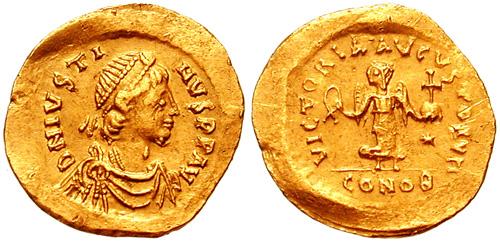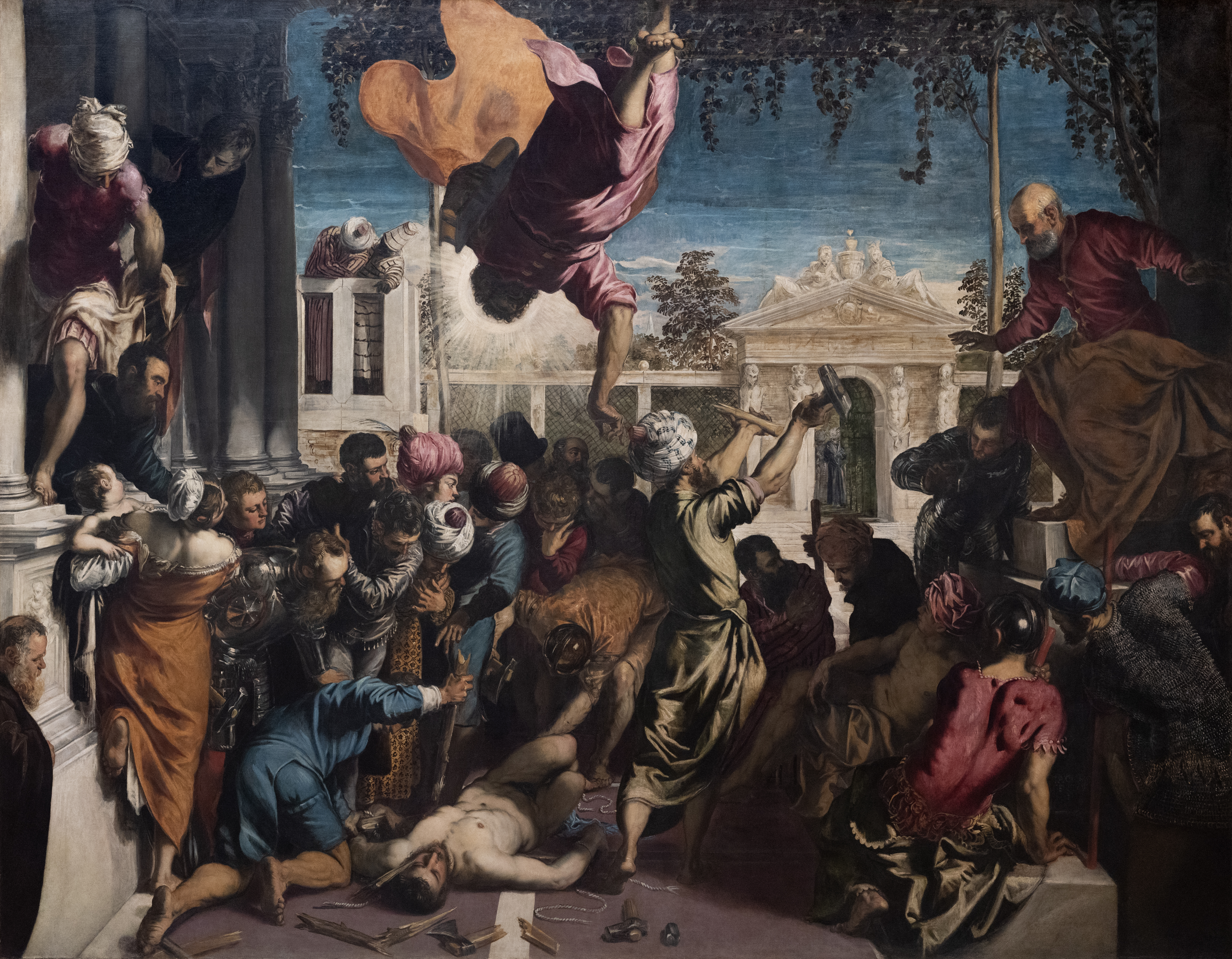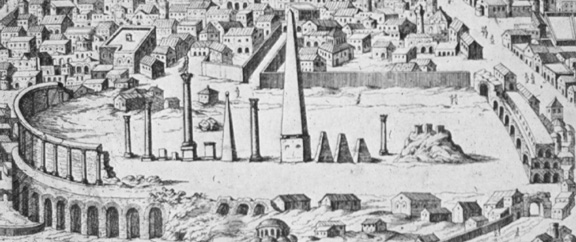|
Basilides (patricius)
Basilides () was a Byzantine official who held the office of ''magister officiorum'' during the reign of Emperor Justinian I (r. 527–565). He was a member of the commission responsible for forming the ''Corpus Juris Civilis''. . On February 13, 528, Basilides was appointed as a member of the commission preparing the ''Corpus Juris Civilis'', serving under Tribonian. Their work was completed in 529. While this is the first chronological mention of him, the text of his appointment mentions him as being already a ''vir excellentissimus'' ("most excellent man"), a former praetorian prefect of the East and a patrician. His title of praetorian prefect has been suggested to be honorific, as modern historians find it strange that Basilides could have served in this high-ranking position prior to holding lower offices.. On April 7, 529, official texts mention Basilides as the serving praetorian prefect of Illyricum, a rank lower than his previous title of praetorian prefect of the East. ... [...More Info...] [...Related Items...] OR: [Wikipedia] [Google] [Baidu] |
Byzantine Empire
The Byzantine Empire, also known as the Eastern Roman Empire, was the continuation of the Roman Empire centred on Constantinople during late antiquity and the Middle Ages. Having survived History of the Roman Empire, the events that caused the fall of the Western Roman Empire in the 5th centuryAD, it endured until the fall of Constantinople to the Ottoman Empire in 1453. The term 'Byzantine Empire' was coined only after its demise; its citizens used the term 'Roman Empire' and called themselves 'Romans'. During the early centuries of the Roman Empire, the western provinces were Romanization (cultural), Latinised, but the eastern parts kept their Hellenistic culture. Constantine the Great, Constantine I () legalised Christianity and moved the capital to Constantinople. Theodosius I, Theodosius I () made Christianity the state religion and Greek gradually replaced Latin for official use. The empire adopted a defensive strategy and, throughout its remaining history, expe ... [...More Info...] [...Related Items...] OR: [Wikipedia] [Google] [Baidu] |
Nika Riots
The Nika riots (), Nika revolt or Nika sedition took place against Byzantine emperor Justinian I in Constantinople over the course of a week in 532 AD. They are often regarded as the most violent riots in the city's history, with nearly half of Constantinople being burned or destroyed and tens of thousands of people killed. Background The Roman Empire had well-developed associations, known as '' demes'', which supported the different factions (or teams) to which competitors in certain sporting events belonged, especially in chariot racing. There were initially four major factions in chariot racing, differentiated by the colour of the uniform in which they competed; the colours were also worn by their supporters. These were the Blues (''Veneti''), the Greens (''Prasini''), the Reds (''Russati''), and the Whites (''Albati''), although by the 6th century the only teams with any influence were the Blues and Greens. Emperor Justinian I was a supporter of the Blues, although his sup ... [...More Info...] [...Related Items...] OR: [Wikipedia] [Google] [Baidu] |
Zooras
Zoora ( Syriac: ܙܥܘܪܐ, ''Zeʿora''; Greek Ζωόρας, ''Zooras'') was a Syrian Miaphysite monk and stylite in the Roman Empire. He moved to Constantinople in the early 530s and was condemned at the Council of Constantinople in 536. He died a few years later. Zoora's life is known mainly from the hagiography written by his contemporary, John of Ephesus, who probably met him in Constantinople around 536. The first part of it is missing. Zoora hailed from the region around Amida. He was short in stature and his name means "small" in Syriac. He received his spiritual training under a certain Habib. Sometime before the Hunnic invasion of 515, during the reign of Anastasius I, he ascended a pillar. Zoora remained a stylite through at least to the end of the reign of Justin I (died 527). He was forced to descend by the Chalcedonians. He went to Constantinople early in the reign of Justin's successor, Justinian I. By this time he was renowned locally and arrived in Constantinople ... [...More Info...] [...Related Items...] OR: [Wikipedia] [Google] [Baidu] |
Excubitors
The Excubitors ( or , , i.e. 'sentinels'; transcribed into Greek as , ) were founded in as an imperial guard-unit by the Byzantine emperor Leo I the Thracian. The 300-strong force, originally recruited from among the warlike mountain tribe of the Isaurians, replaced the older as the main imperial bodyguards. The Excubitors remained an active military unit for the next two centuries, although, as imperial bodyguards, they did not often go on campaign. Their commander, the Count of the Excubitors (, ), soon acquired great influence. Justin I was able to use this position to rise to the throne in 518, and thereafter the Counts of the Excubitors were among the main political power-holders of their day; two more, Tiberius II Constantine and Maurice, rose to become emperors in the late 6th century. In the later part of the 7th century the Excubitors appear to have morphed into a parade-ground formation, and they fade from the record as a corps. Individual seals of office suggest ... [...More Info...] [...Related Items...] OR: [Wikipedia] [Google] [Baidu] |
Constantinople
Constantinople (#Names of Constantinople, see other names) was a historical city located on the Bosporus that served as the capital of the Roman Empire, Roman, Byzantine Empire, Byzantine, Latin Empire, Latin, and Ottoman Empire, Ottoman empires between its consecration in 330 until 1930, when it was renamed to Istanbul. Initially as New Rome, Constantinople was founded in 324 during the reign of Constantine the Great on the site of the existing settlement of Byzantium, and shortly thereafter in 330 became the capital of the Roman Empire. Following the collapse of the Western Roman Empire in the late 5th century, Constantinople remained the capital of the Eastern Roman Empire (also known as the Byzantine Empire; 330–1204 and 1261–1453), the Latin Empire (1204–1261), and the Ottoman Empire (1453–1922). Following the Turkish War of Independence, the Turkish capital then moved to Ankara. Although the city had been known as Istanbul since 1453, it was officially renamed as Is ... [...More Info...] [...Related Items...] OR: [Wikipedia] [Google] [Baidu] |
Pope Agapetus I
Pope Agapetus I (489/490 – 22 April 536) was the bishop of Rome from 13 May 535 to his death on 22 April 536. His father, Gordianus, was a priest in Rome and he may have been related to two popes, Pope Felix III, Felix III and Pope Gregory I, Gregory I. In 536, Agapetus traveled to Constantinople at the behest of King Theodahad of the Ostrogoths and unsuccessfully tried to persuade Emperor Justinian I to call off a Byzantine invasion of the Ostrogoth kingdom. While in Constantinople, Agapetus also deposed the patriarch Anthimus I and personally consecrated his successor who is Patriarch Menas of Constantinople, Menas of Constantinople. Four of Agapetus’ letters from this period have survived: two addressed to Justinian, one to the bishops of Africa, and one to the Bishop of Carthage. Agapetus was canonized in both the Catholic and Orthodox traditions; his feast day is April 22. Family Agapetus was born in Rome, although his exact date of birth is unknown. He was the son ... [...More Info...] [...Related Items...] OR: [Wikipedia] [Google] [Baidu] |
John Of Ephesus
John of Ephesus (or of Asia) (Greek: Ίωάννης ό Έφέσιος, Classical Syriac: ܝܘܚܢܢ ܕܐܦܣܘܣ, c. 507 – c. 588 AD) was a leader of the early Syriac Orthodox Church in the sixth century and one of the earliest and the most important historians to write in Syriac. John of Ephesus was a bishop, but John was more important than other bishops and what sets him apart from most others is the fact that he was a historian and a writer. He was also a political man and would often follow his own path. John was seen as a great writer and covered important aspects of events in history, and one of these important events was the plague, and John has one of the only first-hand accounts of the plague. He was also alive in what has been called the worst year in history, 536. Life Born at the Assyrian inhabited town of Amida (modern Diyarbakır in southeastern Turkey) about 507, he was there ordained as a deacon in 529 by John of Tella at Zuqnin Monastery, When John was ... [...More Info...] [...Related Items...] OR: [Wikipedia] [Google] [Baidu] |
Roman Consul
The consuls were the highest elected public officials of the Roman Republic ( to 27 BC). Romans considered the consulship the second-highest level of the ''cursus honorum''an ascending sequence of public offices to which politicians aspiredafter that of the Roman censor, censor, which was reserved for former consuls. Each year, the Centuriate Assembly elected two consuls to serve jointly for a one-year term. The consuls alternated each month holding ''fasces'' (taking turns leading) when both were in Rome. A consul's ''imperium'' (military power) extended over Rome and all its Roman provinces, provinces. Having two consuls created a check on the power of any one individual, in accordance with the republican belief that the powers of the former King of Rome, kings of Rome should be spread out into multiple offices. To that end, each consul could veto the actions of the other consul. After the establishment of the Roman Empire, Empire (27 BC), the consuls became mere symboli ... [...More Info...] [...Related Items...] OR: [Wikipedia] [Google] [Baidu] |
Miracle
A miracle is an event that is inexplicable by natural or scientific lawsOne dictionary define"Miracle"as: "A surprising and welcome event that is not explicable by natural or scientific laws and is therefore considered to be the work of a divine agency." and accordingly gets attributed to some supernatural or praeternatural cause. Various religions often attribute a phenomenon characterized as miraculous to the actions of a supernatural being, (especially) a deity, a miracle worker, a saint, or a religious leader. Informally, English-speakers often use the word ''miracle'' to characterise any beneficial event that is statistically unlikely but not contrary to the laws of nature, such as surviving a natural disaster, or simply a "wonderful" occurrence, regardless of likelihood (e.g. "the miracle of childbirth"). Some coincidences may be seen as miracles. A true miracle would, by definition, be a non-natural phenomenon, leading many writers to dismiss miracles as physically i ... [...More Info...] [...Related Items...] OR: [Wikipedia] [Google] [Baidu] |
Hagia Sophia
Hagia Sophia (; ; ; ; ), officially the Hagia Sophia Grand Mosque (; ), is a mosque and former Church (building), church serving as a major cultural and historical site in Istanbul, Turkey. The last of three church buildings to be successively erected on the site by the Byzantine Empire, Eastern Roman Empire, it was completed in AD 537, becoming the world's largest interior space and among History of Roman and Byzantine domes, the first to employ a fully pendentive dome. It is considered the epitome of Byzantine architecture and is said to have "changed the history of architecture". From its dedication in 360 until 1453 Hagia Sophia served as the cathedral of Constantinople in the Divine Liturgy#Byzantine Rite, Byzantine liturgical tradition, except for the period 1204‑1261 when the Latin Empire, Latin Crusaders installed their own Hierarchy of the Catholic Church, hierarchy. After the fall of Constantinople in 1453, it served as a mosque, having its Minaret, minarets added ... [...More Info...] [...Related Items...] OR: [Wikipedia] [Google] [Baidu] |
Hippodrome Of Constantinople
The Hippodrome of Constantinople (; ; ) was a Roman circus, circus that was the sporting and social centre of Constantinople, capital of the Byzantine Empire. Today it is a square in Istanbul, Turkey, known as Sultanahmet Square (). The word ''hippodrome'' comes from the Greek (), horse, and (), path or way. For this reason, it is sometimes also called ("Horse Square") in Turkish. Horse racing and chariot racing were popular pastimes in the ancient world and hippodromes were common features of Greek cities in the Hellenistic, Ancient Rome, Roman, and Byzantine eras. History and use Construction Although the Hippodrome is usually associated with Constantinople's days of glory as an imperial capital, it actually predates that era. The first Hippodrome was built when the city was called Byzantium, and was a provincial town of moderate importance. In AD 203 the Emperor Septimius Severus rebuilt the city and expanded its city wall, walls, endowing it with a hippodrome, an ... [...More Info...] [...Related Items...] OR: [Wikipedia] [Google] [Baidu] |
Quaestor Sacri Palatii
The ''quaestor sacri palatii'' (, usually simply ; English: Quaestor of the Sacred Palace) was the senior legal authority in the late Roman Empire and early Byzantine Empire, Byzantium, responsible for drafting laws. In the later Byzantine Empire, the office of the ''quaestor'' was altered and it became a senior judicial official for the imperial capital, Constantinople. The post survived until the 14th century, albeit only as an honorary title. Late Roman ''quaestor sacri palatii'' The office was created by Emperor Constantine I (), with the duties of drafting of laws and the answering of petitions addressed to the emperor. Although he functioned as the chief legal advisor of the emperor and hence came to exercise great influence, his actual judicial rights were very limited.. Thus from 440 he presided, jointly with the praetorian prefect of the East, over the supreme tribunal in Constantinople which heard appeals (the so-called ''causae sacrae'', since these cases were original ... [...More Info...] [...Related Items...] OR: [Wikipedia] [Google] [Baidu] |







